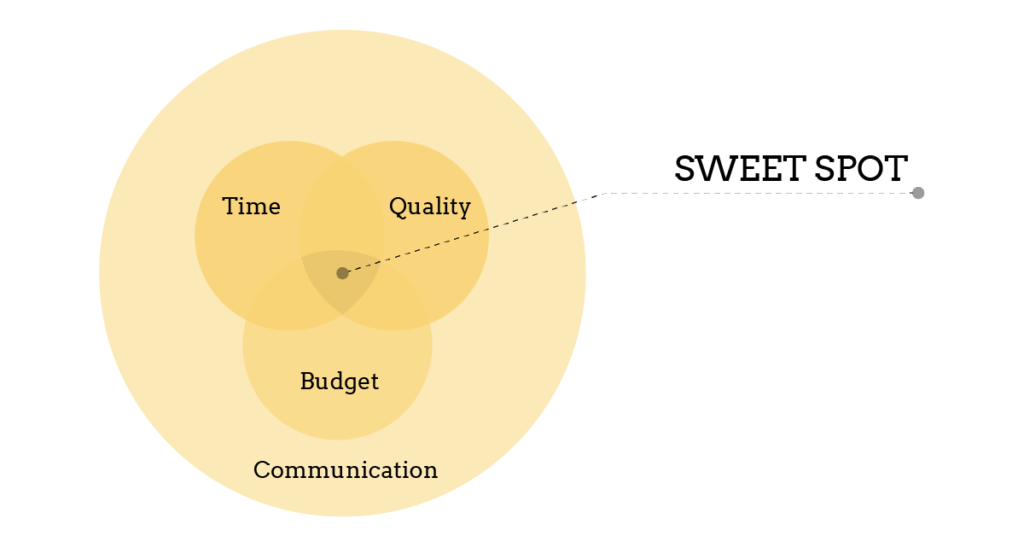Last Updated on January 3, 2025
Article Contents
Creative Project Management – A Constant Evolution
Managing creative projects involves a unique blend of flexibility, communication, and organization. Creative project management isn’t just about meeting deadlines; it’s a dynamic process of guiding innovative work from concept to completion. Unlike traditional project management, where processes are often linear, creative projects require adaptability, collaboration, and an evolving approach. In this guide, we’ll explore what creative project management entails, the tools and processes that support it, and the best practices for success.
What is Project Management?
Project management is the structured approach of planning, executing, and overseeing a project to meet specific goals. In most industries, it includes managing timelines, budgets, quality, and communication across teams. However, creative production management introduces additional challenges, as creative projects often involve subjective, evolving objectives. What is creative project management? It’s a specialized approach that balances structure with the flexibility required for innovation, ensuring that both the artistic vision and business objectives are met.
Effective project management techniques often include strategies to help teams overcome creative block and maintain productivity.
Ideal Project Management Process for Creative Teams
An effective creative project management process keeps the team aligned with the goals while allowing room for creativity. The core elements—time, quality, budget, and communication—are closely interconnected in creative project management but deserve individual focus for clarity. Here’s how these elements work together:
Time
Time is one of the most critical components of any project. In creative projects, managing time is about balancing deadlines with the need for exploration and iteration. While deadlines are essential, creatives need flexibility to brainstorm and revise their work. Effective creative project management tools like Asana or Trello can assist in tracking deadlines without compromising creative freedom.
Quality
Quality control ensures that the final deliverables meet the client’s expectations. Unlike other industries where quality can be measured objectively, creative quality can be subjective. In creative project management, maintaining quality involves setting clear standards, providing constructive feedback, and conducting regular reviews to ensure the output aligns with the vision.
Budget
Budget management in creative projects often involves adapting costs to changing requirements. Creative projects sometimes encounter budgetary shifts due to design changes or additional client requests. Managing a flexible budget requires transparency and open communication with both the team and the client to prevent scope creep.
Communication
Communication is the glue that holds a project together, especially in creative work where ideas and feedback evolve. Clear, continuous communication between creative teams and clients helps manage expectations and fosters collaboration. Regular check-ins and progress updates ensure everyone is aligned with the project goals.
How We Creatively Manage Our Projects at Mypromovideos – A Glimpse
At Mypromovideos, we believe in practicing what we preach. Our approach to creative project management is designed to support collaboration and innovation. Here’s how we manage our projects creatively:
- Defining the Project Scope: We begin by clearly defining the project scope with the client, detailing goals, deliverables, timelines, and budgets to ensure a shared vision from the start.
- Flexible Timeline Management: We understand that creative projects often evolve, so while we set timelines, we also allow room for adjustments. Our project managers use tools like Asana to keep the timeline on track while accommodating any creative adjustments.
- Quality Checks at Every Stage: From concept to completion, we ensure quality through regular reviews and feedback sessions. This helps us align our work with both client expectations and our internal standards.
- Transparent Communication: Our project managers foster open communication channels between clients and creative teams. We use platforms like Slack for team updates and Zoom for client meetings, ensuring everyone is informed and engaged at every stage.
Creative Project Management vs. Other Types of Project Management
While traditional project management follows a more structured, predictable approach, creative project management is flexible and iterative. In industries like construction or manufacturing, project phases are strictly linear. However, creative projects require frequent adjustments, brainstorming sessions, and revisions. This iterative process is less rigid, allowing for the evolution of ideas and innovation. For instance, a creative project manager might need to adapt the timeline or budget mid-project to align with new creative insights, making the process both challenging and rewarding.
Evolution of Project Management Tools
Over the years, creative project management tools have transformed from basic task management systems to comprehensive platforms that support collaboration, communication, and flexibility. Tools like Asana, Monday.com, and Trello are widely used in creative teams, offering customizable workflows that allow teams to visualize the project process. These tools support the unique demands of creative projects by accommodating flexible timelines, integrating with design software, and offering visual layouts that align well with creative work processes.
Best Practices for Creative Project Management
Here are some actionable creative project management examples and practices to ensure smooth and successful project management in creative fields:
- Define Clear Objectives: Establishing clear project goals from the beginning helps guide the creative direction and keep everyone on the same page.
- Maintain a Flexible Timeline: Allow room for iteration and feedback, as creative work often requires multiple rounds of revision.
- Foster Open Communication: Regularly update both clients and team members on progress and encourage feedback. Effective communication tools like Slack or Microsoft Teams can streamline this process.
- Use Visual Planning Tools: Creative teams benefit from visual task boards or timelines. Tools like Trello or Miro offer visual project layouts that align well with creative workflows.
- Encourage Collaboration: Creative projects thrive on teamwork. Schedule brainstorming sessions and collaborative reviews to allow ideas to evolve organically.
- Prioritize Quality Control: Schedule quality checks at key stages to ensure that deliverables align with both client expectations and creative standards.
FAQs Related to Creative Project Management
How does project management differ for creative teams compared to other industries?
Project management for creative teams is more fluid and flexible, allowing for adjustments as ideas evolve. Unlike traditional industries where timelines and outcomes are rigid, creative production management prioritizes adaptability and ongoing feedback to meet subjective quality standards.
How does creative project planning differ from traditional project planning?
In creative project management, planning is often less linear. Traditional project planning relies on fixed phases, whereas creative project planning integrates feedback loops, brainstorming, and the flexibility to accommodate changes in direction or scope.
What are some strategies for effectively managing client expectations in creative projects?
Managing client expectations in creative projects requires clear communication and transparency. Start by setting realistic expectations for deliverables and timelines, and keep clients updated throughout the process. Creative project management tools with client collaboration features, like Monday.com, can also streamline feedback and approval processes.
In a world where creativity and adaptability are paramount, creative project management is a constantly evolving discipline. It’s about balancing structure with the flexibility that innovative work demands, ensuring that creative teams can thrive without compromising quality or client expectations. By adopting the right tools, processes, and best practices, you can manage creative projects that not only meet but exceed expectations.

